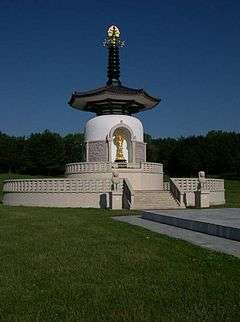Willen
Coordinates: 52°03′47″N 0°43′09″W / 52.06311°N 0.71922°W
Willen is a district of Milton Keynes, England and is also one of the ancient villages of Buckinghamshire to have been included in the designated area of the New City in 1967. At the 2011 Census the population of the district was included in the civil parish of Campbell Park. The original village is now a small but important part of the larger district that contains it and to which it gives its name.
Environment and amenities
The tiny parish church (1680) at Willen was designed by the architect and physicist Robert Hooke and is a classic of the early English Baroque period.
Further around the lake, there is a Buddhist Temple/monastery and a large stupa, a Peace Pagoda built in 1980 by the Monks and Nuns of the Nipponzan-Myōhōji. It was the first to be built in the western hemisphere. There is a grass labyrinth nearby.
Willen Lake
One of the more important features of the district is a large balancing lake on the River Ouzel, designed to capture flash floods lest they cause problems down stream. The north basin is a wild-life sanctuary and a favourite of migrating aquatic birds. The south basin is for leisure use, favoured by wind surfers and dinghy sailors. The circuit of the lakes is a favoured "fun run".
Willen Hospice
Overlooking the lake, Willen Hospice provides specialist care for people whose illness no longer responds to curative treatment (also known as specialist palliative care).
Bird Life
In its history, many rare and scarce migrating birds have turned up on the north side of the lake. The island that has 3 resident goats to graze the vegetation, is primarily for bird life. Many common bird species breed on the spit that can be viewed from the only hide on the lake, the north hide. Here are some of the most notable visitors to the lake: Red-throated Diver (1986), Great Northern Diver (1994), Fulmar (2001) Great Shearwater (1999), Leach's Petrol (1987), Gannet (2002), Night Heron (1987), Glossy Ibis (1987), Spoonbill (1995), Pink footed Goose (1992), White-Fronted Goose (1992), Green-Winged Teal (1994), Ring-Necked Duck (1996), Long-Tailed Duck (1981), Velvet Scoter (2006), Spotted Crake (1995), Avocet (2011), Kentish Plover (1981), Temmick's Stint (2004), Pectoral Sandpiper (1995), Purple Sandpiper (1977), Red-Necked Phalarope (1995), Grey Phalarope (1987), Wilson's Phalarope (2007), Pomarine Skua (1982), Great Skua (1987), Sabine's Gull (1981), Caspian Tern (2001), Roseate Tern (1994), Whiskered Tern (2001), Cetti's Warbler (2011), Great Reed Warbler (2008), Golden Oriole (1997), Lapland Bunting (1966), Snow Bunting (1997), and a pair of Black-winged Stilt staying the summer of 1988.
History
The village was first recorded as Wilinges (12th century) and later as Wylie, Wilies (13th century); Wilne, Wylyene (14th century); and Wyllyen, Wyllyn (15th century). Willen is not recorded by name in the Domesday Survey, but it can be identified with the 4 hides 1 virgate assessed under Caldecote, part of the neighbouring parish of Newport Pagnell, and held under the Count of Mortain by Alvered.[1] The name Willen is probably from Anglo-Saxon or Old English meaning (at the) 'willows' the River Ouzel meanders through land ideal for willows. The Willen civil parish was merged with Great and Little Woolstone to become Woolstone-cum-Willen in 1934. It is now part of the parish of Campbell Park.
Miscellaneous
Church of St Mary Magdalene was dedicated to St Mary Magdalene. The district is also home to Willen Cricket Club formed in the mid-1990s by Ken Jones and Tony Walsh and Willen Juniors FC who both play at Willen Fields on Portland Drive.
References
- ↑ 'Parishes : Willen', Victoria History of the Counties of England: A History of the County of Buckingham: Volume 4 (1927), pp. 502-505. URL: Date accessed: 12 August 2009.
External links
| Wikimedia Commons has media related to Willen. |
- Map and detailed aerial photography from MKWEB
- Map sources for Willen
- The official website for the Milton Keynes Peace Pagoda
- A panoramic virtual tour of Willen Church by Peter Loud

